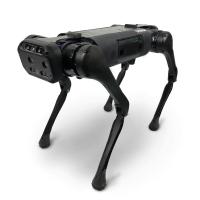Researchers at Cornell University have come up with a virtual demonstration that shows how robotic creatures can evolve quickly – and may someday perform advanced functions in demand by the marketplace.
By using 3D printing, algorithms and theories such as natural selection, the research team at the Cornell Creative Machines Lab helps the public understand the evolution of these simulated robots.
The study uses soft robots – and watches as they evolve.
“This is achieved through the use of simulated muscles, tissues and bones, as well as the use of a DNA encoding which is based off of the way cell differentiation actually occurs in developmental biology,” explained one of the key researchers, Nick Cheney, a doctoral student at Cornell.
3D printing technology was important to the study, as well. Researchers were able to print 3D forms of arbitrary shapes, and can also use the technology for bone replacements, tissues, muscles and stem cells.
Some of the study relied on past scientific and engineering knowledge.
“The idea of an algorithm which abstracts evolution – in its heritable traits, mating and passing of genes with variations and mutations, and competition over scarce resources – to solve optimization problems in engineering has been around for decades,” Cheney explained to RobotXworld. “However, we believe that we have created the simplest and most powerful visualization of evolution.”
In addition, it was striking how the team watched as evolution had the ability to “create a vast and diverse array of behaviors from a simple goal, the ability to fine-tune these behaviors to accommodate specific pressures or constraints, and simply the ability to do all of this based on the power of evolution itself – with no design insights or guidance by any of us as experimenters. We didn't tell it to create robots with symmetrical bodies, or four legs, or any type of specific designs, we just gave it the basic building blocks of soft materials and told it to evolve creatures to fulfill a high level goal – in this case locomotion – and natural selection did the rest,” Cheney said.
Looking ahead, Cheney predicts that there is a “tremendous potential” for commercial and engineering applications of evolutionary robotics.
Robots now are often used in controlled and repetitive environments like assembly lines. But a new direction is ahead.
“We see robotics trying to break free of these roles and perform even simple autonomous tasks in unpredictable environments – like the Roomba home cleaning robot – but so far there has been relatively little success on this front,” Cheney said. “Designing these types of robots is a very difficult task, and one that we have yet to master as engineers. However, evolution has created a multitude of animals that thrive in these unpredictable environments. Our hope, as a field, is to capture the essential aspects of evolution in our algorithms and to be able to create artificial organisms that exhibit these robust and adaptive behaviors.”
Eventually, the evolution of soft robots will move from locomotion to higher level cognitive functions. The more advanced goals for the robots are many years away. But it starts with making autonomous and robust robots. Then it will move to tasks which human beings may not want to perform. Cleaning, search and rescue, and construction work are examples.
“Fitting with this goal, we strive to understand the core mechanisms of evolutionary algorithms – and the other aspects of biology that affect evolution, such as environmental pressures, social interactions, genetic encoding, ecosystem niches, etc. – to be optimally situated to create complex robotic brains and bodies as our increasing computational technologies allow us to further scale these algorithms,” Cheney said. “At the same time, we seek a symbiotic relationship with our partners in biology, genetics, development, psychology, cognitive science, etc. to help inform each other, and to create and answer questions across disciplines. Their knowledge of these natural systems, and our ability to simulate vast numbers of parallel trials exposing evolutionary trends with specific experimental conditions on the order of hours or days instead of millions of years, give this relationship unbelievable potential.”





